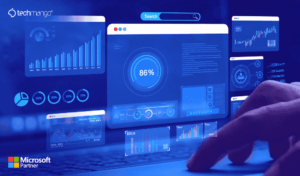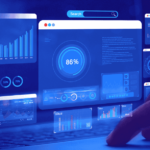As we delve deeper into the digital age, businesses are increasingly relying on custom business applications to streamline operations, enhance productivity, and drive growth. With technology evolving at a rapid pace, it’s crucial for businesses to stay abreast of the latest trends in custom business application development. In this blog post, we will outline the key trends that are shaping the landscape of custom business application development in 2023.

Low-Code/No-Code Development Platforms
Rise of Low-Code/No-Code Development
Low-code and no-code development platforms have witnessed a significant rise in popularity and adoption in recent years, and this trend is expected to continue in 2023. These platforms provide a visual interface and drag-and-drop functionality that simplifies the app development process, reducing the need for extensive coding knowledge.
With low-code platforms, developers can use visual modeling and pre-built components to quickly create custom business applications. On the other hand, no-code platforms enable business users with little to no coding experience to build applications themselves. This empowers non-technical professionals to become active contributors to the app development process, freeing up IT teams for more complex tasks.
Increased Business User Empowerment
One of the key advantages of low-code/no-code development platforms is the increased empowerment of business users. These platforms offer intuitive tools and user-friendly interfaces that enable individuals from various departments to actively participate in application development.
Business users can leverage their domain knowledge to design, customize, and modify applications to meet their specific requirements, reducing dependency on IT departments.
This trend promotes a collaborative environment between business and IT teams, allowing for faster development cycles and quicker iterations. Business users can provide real-time feedback and make adjustments to the application based on evolving needs, enhancing the agility and responsiveness of the development process.
In conclusion, the rise of low-code/no-code development platforms in 2023 is transforming custom business application development. These platforms empower both developers and business users to create applications efficiently, accelerating the development process and fostering collaboration between different stakeholders.
The increased accessibility and involvement of non-technical professionals contribute to the enhancement of mobile app development, driving innovation and addressing the growing demand for customized solutions in businesses of all sizes.
Cloud-Native and Microservices Architecture
Embracing Cloud-Native Approach:
In 2023, businesses are increasingly adopting a cloud-native approach to custom business application development. Cloud-native architecture is designed to fully leverage the capabilities of cloud computing platforms. It involves building applications with a set of principles and practices that maximize scalability, flexibility, and efficiency in the cloud environment.
By utilizing cloud-native technologies such as containers, orchestration tools like Kubernetes, and serverless computing, businesses can develop applications that are highly scalable, resilient, and adaptable to changing business demands. Cloud-native applications are designed to take full advantage of the cloud’s distributed and elastic nature, enabling automatic scaling, efficient resource utilization, and reduced infrastructure costs.
Microservices Architecture for Modular Development:
Microservices architecture continues to gain prominence as a favored approach for custom business application development. This architectural style involves breaking down applications into smaller, loosely coupled services, each responsible for a specific business function or capability. These services can be developed, deployed, and scaled independently, allowing for greater agility and scalability.
The use of microservices architecture offers several benefits. It enables teams to work on different services simultaneously, facilitating faster development and deployment cycles. Each service can be developed using the most suitable technology stack and can be scaled independently to handle varying workloads. Additionally, the modular nature of microservices allows for easier maintenance, updates, and fault isolation, as issues in one service do not impact the entire application.
In 2023, businesses are embracing microservices architecture to build custom business applications that are flexible, resilient, and easily adaptable to changing market demands. This approach facilitates rapid development, enables the use of diverse technologies, and enhances the overall scalability and maintainability of applications.
In short, the adoption of cloud-native and microservices architecture in custom business application development is a significant trend in 2023. Businesses are leveraging the benefits of cloud computing, containerization, and modular design to create scalable, resilient, and flexible applications. The cloud-native approach and microservices architecture enable businesses to effectively utilize cloud resources, optimize performance, and achieve greater agility in the development and deployment of custom applications.
AI-Powered Applications and Automation
Integration of Artificial Intelligence (AI)
Artificial Intelligence (AI) continues to shape the landscape of custom business application development in 2023. AI technologies such as machine learning, natural language processing, and computer vision are being integrated into applications to automate processes, improve decision-making, and enhance user experiences.
Machine learning algorithms enable applications to analyze large datasets, detect patterns, and make predictions or recommendations. This helps businesses gain valuable insights, automate repetitive tasks, and improve operational efficiency.
Natural language processing enables applications to understand and respond to human language, facilitating chatbots, voice assistants, and intelligent search functionalities. Computer vision allows applications to interpret and analyze visual data, enabling tasks such as image recognition, object detection, and augmented reality experiences.
Related Blog
What is AI-powered Native App Development
Robotic Process Automation (RPA):
Robotic Process Automation (RPA) is another significant trend in custom business application development. RPA involves automating repetitive and rule-based tasks using software bots or “robots.” These bots can interact with multiple applications, extract and process data, perform calculations, and generate reports.
By automating mundane and time-consuming tasks, RPA allows employees to focus on higher-value activities that require human judgment and creativity.
RPA offers several benefits to businesses, including increased efficiency, improved accuracy, and enhanced scalability.
It streamlines workflows, reduces manual errors, and enables organizations to handle larger workloads without the need for additional human resources. In 2023, we can expect to see increased adoption of RPA in custom business applications, leading to enhanced operations and improved productivity.
Related Blog
How Smart AI-Powered Based Chatbot Solution Helps Enterprises
Enhanced User Experience and Mobile-First Approach
User-Centric Design:
In 2023, the focus on user experience (UX) in custom business application development continues to be paramount. User-centric design principles are embraced to ensure that applications are intuitive, user-friendly, and tailored to meet the needs of the target audience. This approach involves conducting user research, understanding user behaviors and preferences, and incorporating their feedback throughout the development process.
By implementing user-centric design, businesses can create applications that provide seamless and engaging experiences. Intuitive interfaces, logical workflows, and personalized interactions are prioritized to enhance user satisfaction and productivity. Usability testing and iterative design cycles are employed to refine the application and address any usability issues, ensuring a positive user experience.
Mobile-First Strategy:
The prevalence of mobile devices has led to a mobile-first approach in custom business application development. With a growing number of employees relying on smartphones and tablets for work, businesses are prioritizing mobile accessibility and responsiveness in their applications.
A mobile-first strategy involves designing and developing applications specifically for mobile devices, considering factors such as smaller screen sizes, touch-based interactions, and on-the-go usage. Applications are optimized for mobile platforms to ensure seamless performance, intuitive navigation, and efficient access to key functionalities.
Conclusion
The trends discussed in this blog outline the evolving landscape of custom business application development in 2023. By embracing these trends, Techmango helps businesses to create applications that are efficient, user-friendly, and adaptable to changing market demands. The integration of innovative technologies, coupled with a focus on user experience and mobile accessibility, empowers businesses to drive growth, improve operational efficiency, and gain a competitive edge in today’s digital landscape.
Feel free to reach us to make your digital transformation journey fulfilled.







